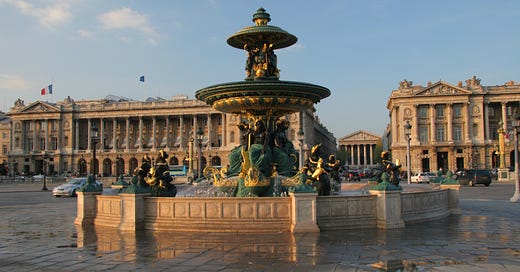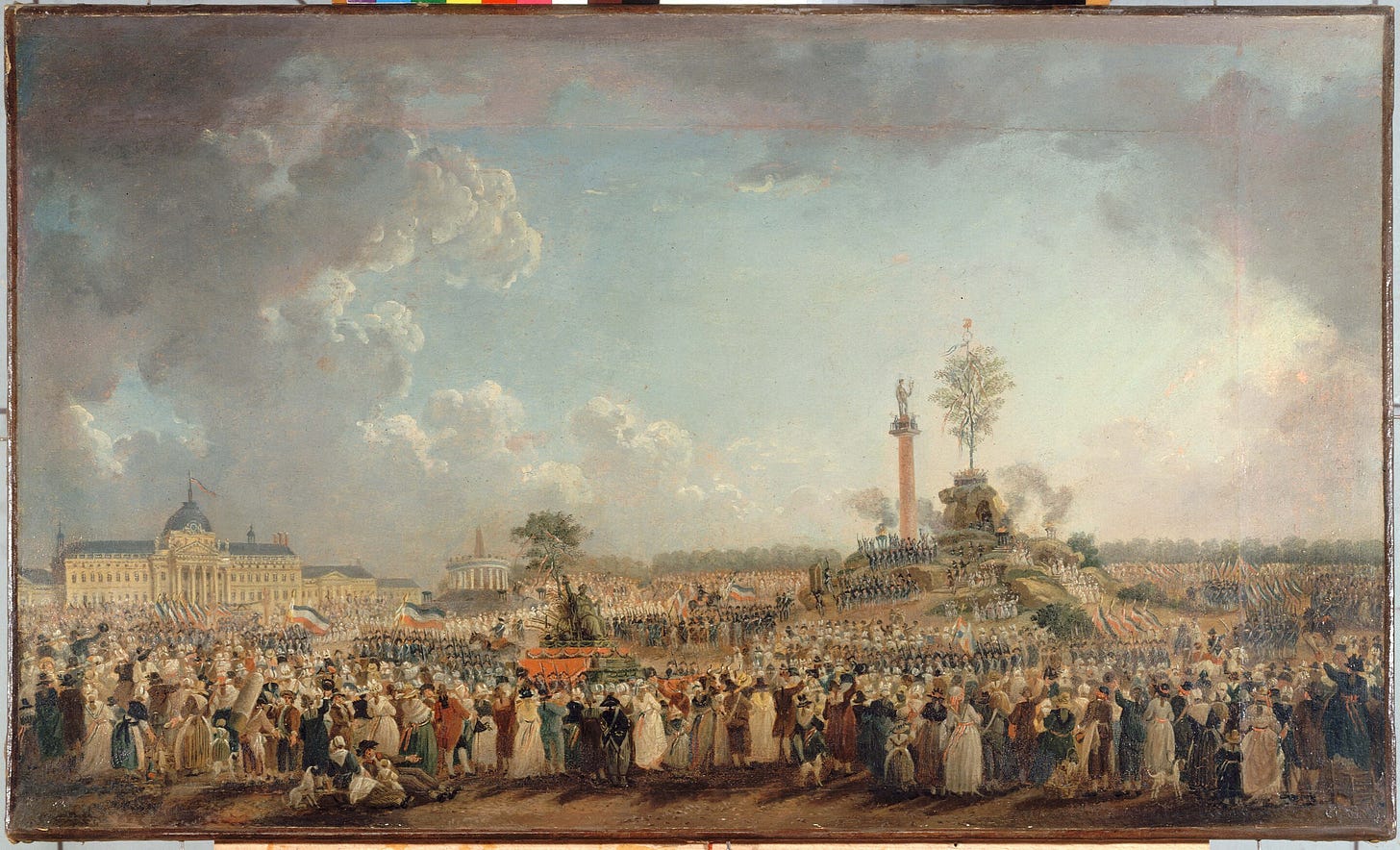I always wanted to return to Paris. As a four-year-old, my memories of the City of Light were not sustainable. Then in 2014, I got the chance when we spent two weeks in the historic city.
Among the sites I wanted to see was the grand square named le Place de la Concord, specifically the center ellipse, from where you can look up the Champs-Élysées and see the Arc de Triomphe in the distance. I had two reasons. It’s where Gene Kelly drew his inspiration for choreographing the grand “dance sequence” in An American in Paris, beautifully performed by Leslie Caron and Gene Kelly himself. I found the majestic fountains and excitedly walked around each, snapping photos and hearing George Gershwin’s concerto in my head. Then, I thought of the second reason and my mood turned solemn.
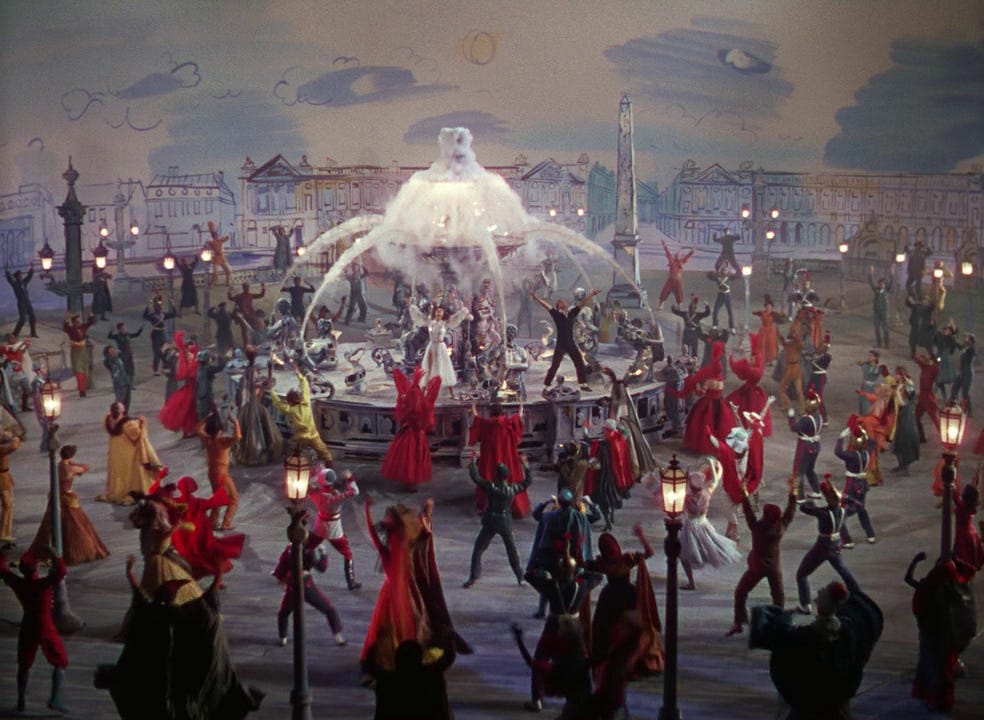
If dramatic events of history can imbibe a place with spiritual presence, it’s there infused into the ground below the centuries-old paving stones of the square. The most shocking event associated with the square happened on the 17th of July, 1794.
That month, sixteen nuns of the Community of the Carmel of Compiegne were arrested and brought to Paris in carriages. After spending two nights in the Conciergerie, on July 17th, the nuns were brought to trial and condemned to be executed a few hours later. The reason given by the judge was this: “You are to die because you insist on remaining in your convent in spite of the liberty we gave you to abandon all such nonsense.” “We have now heard the true reason for our arrest and condemnation,” one nun spoke out. “It is because of our religious beliefs that we are to die.”
Each of the Sisters, one by one, beginning with the youngest willingly placed themselves on the block of the scaffold, making an offering to God of their lives on behalf of the people and in union with the Sacrifice of Jesus. The Prioress was given the option of being the last to die. After she had encouraged each of her community and received their vows she knelt down and renewed her religious profession in a clear voice and kissed the statue of Our Lady as the others had done. With heroic courage she mounted the scaffold chanting the Salve Regina until her voice was silenced on earth.1
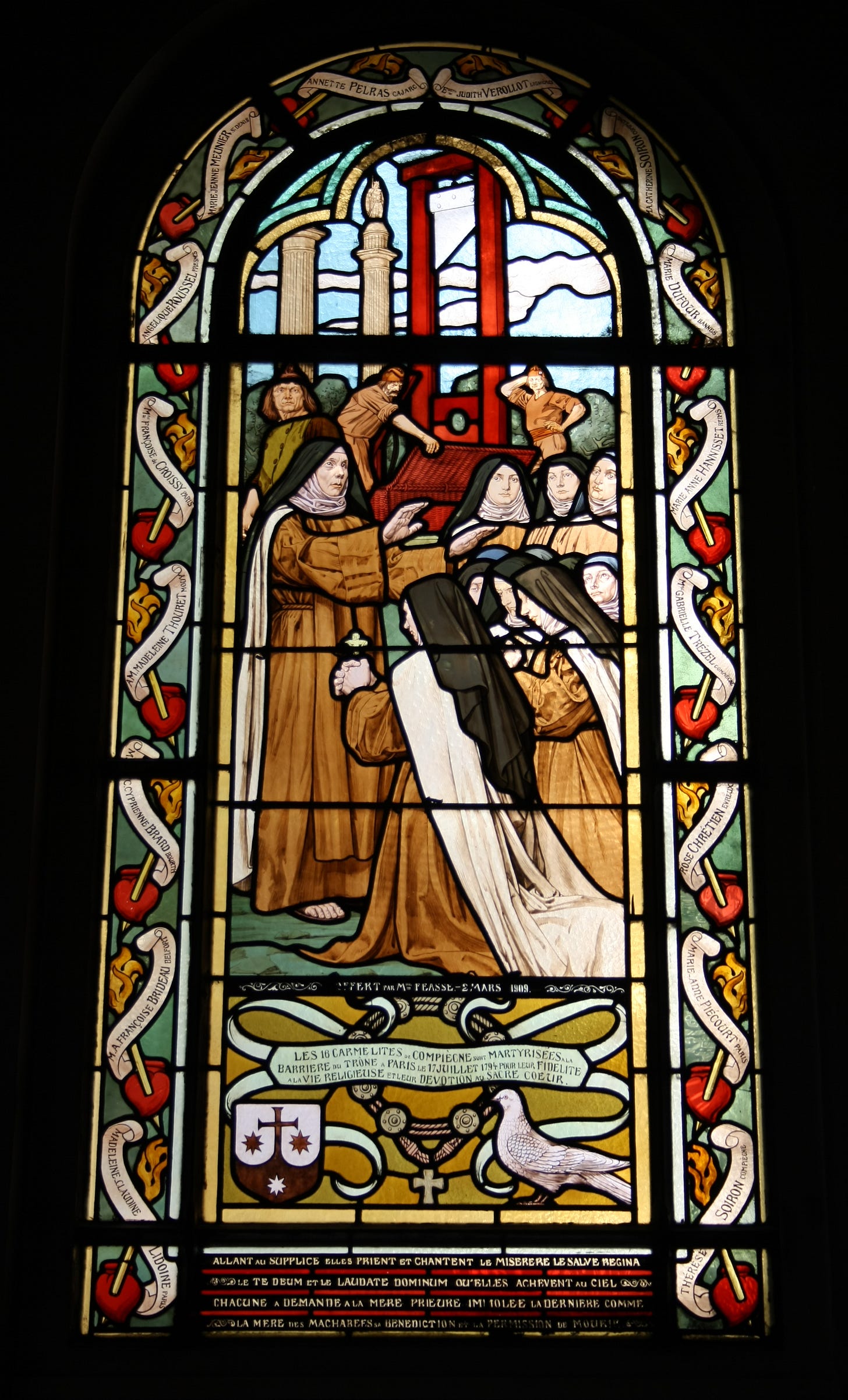
The Martyrs of Compeigne, as they became known, were women who lived as Carmelite Nuns. They bore no threat to the Committee of Public Safety nor anyone in France. Yet, they were brutally executed with the cold machine-like regularity of a regime dedicated to achieving its political goals by any means necessary. By that time, the executing machine, known as “the national razor,” had dispatched nearly 17,000 souls to the jeers of a mob drunk on revolutionary endorphins. This time was different. The mob had never seen nuns being executed. Neither had they witnessed a group of women so bravely and willingly go to their own deaths. Several accounts of the event report that, for the first time, the crowd was silent as they listened to the singing of the nuns get softer and softer as each woman was dispatched, finally going silent when the Prioress herself was beheaded.
Ten days later, Maximilien Robespierre, Louis Antoine de Saint-Just, and Georges Couthon, the architects of the Reign of Terror that murdered the nuns, themselves fell under the blade. Had they just “gone too far?” Or was their approach an atrocity from the very beginning?
The Delusion of Consequentialsim
What leads people to believe that the end justifies the means? It’s certainly nothing new. As an approach, Consequentialism has been around for centuries. And for centuries, it has led to horrible suffering in the name of something good – the proverbial “road to Hell paved with good intentions.” The slippery slope of Consequentialism is so slick, falling to its atrocities is almost inevitable. And lest anyone think that any religion, government, or social movement is immune, think again. 222 years earlier, Paris endured the Saint Bartholomew's Day massacre, an event that one historian describes as making “the red wedding” in Game of Thrones” look like a tea party for children.3 It was orchestrated by Queen Catherine de' Medici to lure French Huguenots to Paris under the guise of celebrating the wedding of her Catholic daughter Margaret to the Protestant Henry of Navarre. Before the day of the wedding ended, hundreds of Huguenots were floating dead in the Seine.
Religious persecution has stained almost every religion of the world up to the present day. But, neither has the opposition to religion been immune. When the nuns were murdered, Robespierre had just led a grand celebration dedicated to “the virtue of reason.” He declared it "the Festival of the Supreme Being" and he was their supreme “priest.” Reason itself had slipped to the depths of depravity.
One would think that by now we would have learned. Yet, despite the overwhelming historical evidence, people of the 21st Century continue to believe that their ideological or political goals can and should be achieved “by any means necessary,” which in practice more accurately translates as “by any means available.” As interest in history has waned, Consequentialism has increased to become a contagion that has infected every political and ideological persuasion, declared to be done in the name of the people, just as the Committee of Public Safely did in 1794. As in the past, people’s livelihoods have been ruined, families split apart, speech itself suppressed, and individuals murdered, all in the name of a humane goal.
The warnings of the moral depravity of this belief are present in modern writing, both non-fiction and fiction.
In Ken Burns’ the Civil War, prominent authors and historians were asked why they think the Civil War happened. I found Shelby Foote’s answer the most interesting and most salient to the past two decades in America:
“It is because we failed to do the thing we really have a genius for, which is compromise. Americans like to think of themselves as uncompromising. Our true genius is for compromising. Our whole government is founded on it. And it failed.” 5
JRR Tolkien challenged Consequentialism in a passage from The Fellowship of the Ring in which Gandalf admonishes Frodo for saying that Gollum deserves death:
“Deserves it! I daresay he does. Many that live deserve death. And some that die deserve life. Can you give it to them? Then do not be too eager to deal out death in judgement. For even the very wise cannot see all ends.” 6
If even the very wise cannot see all ends, then how can one morally justify means to an end when that end is, not only unclear, but potentially unworthy? As the morality of an end becomes murkier, the ethical price of the means becomes costlier. If it turns out that the end itself is unworthy of any pursuit, then the price of the means becomes in itself a wanton act of cruelty. How will people who cancelled their own families for nothing achieve forgiveness, let alone trust? How will people who ruined other people’s lives for nothing restore those lives? They can’t.
J.K. Rowling, herself the target of vicious attacks, warns us through Professor Dumbledore:
“Remember, if the time should come when you should have to make a choice between what is right and what is easy, remember what happened to a boy who was good, and kind, and brave, because he strayed across the path of Lord Voldemort. Remember Cedric Diggory.” 7
While some people may consider the uncompromising approach of “by any means necessary” the right choice, it’s actually the easy choice. Consequentialism thrives in tribal mentality, in which people who commit cruelty for the sake of an end can find comfort from their misgivings about what they are doing. The tribe gives them constant reassurance because the tribal narrative is never considered wrong. Neither does conviction, in itself, guarantee what one is doing is right. Having the courage of one’s convictions is often lauded as a hallmark of bravery. But what bravery is there in having a conviction that conforms to the narrative of the tribe? More importantly, what bravery is there in fulfilling a conviction through cruelty?
Two Sides of the Same Coin
In the Jewish and Christian traditions, justice and righteousness are inextricably linked, often described as being on each side of the same coin. While many people understand the meaning of justice, righteousness is often erroneously associated with self-righteousness, having more of a meaning aligned with being sanctimonious. The concept of righteousness in many religious traditions refers to being in “right relationships” with God and with each other. Kindness, compassion, and treating our neighbor as we would have ourselves treated are inherent to that definition. So, justice cannot be achieved by sacrificing righteousness to achieve a just outcome.
Yet, this is exactly what proponents of Critical Social Justice are insisting must be done. The nonsensical belief that injustice can only be opposed through injustice makes a mockery of justice itself. People who commit an unjust act to oppose the same unjust act cast the immorality of their action on to the people they target, because, according to this belief, their use of injustice is justified whereas their victim’s use of that same injustice is not. When people adhere to an ideology that leverages this kind of illiberal thinking, the door is opened for adherents to self-justify committing almost any atrocious act, including violence.
The Myth of Redemptive Violence
Walter Wink’s treatise on the Myth of Redemptive Violence is brought back, not as a warning, but as a blueprint for how to move the mission of the tribe forward through violence. In 1999, Walter Wink wrote:
“The belief that violence “saves” is so successful because it doesn’t seem to be mythic in the least. Violence simply appears to be the nature of things. It’s what works. It seems inevitable, the last and, often, the first resort in conflicts. If a god is what you turn to when all else fails, violence certainly functions as a god. What people overlook, then, is the religious character of violence. It demands from its devotees an absolute obedience-unto-death.”8
Since his piece was published, the concept of redemptive violence has expanded from children’s cartoons to entire “franchises” of superhero series. The stories are almost boiler plate. The heroes, though flawed are inherently good. They endure assaults that would kill the average person. The villains are very powerful, devoid of any humanity, and beyond redemption, thus no need for due process. Their followers are portrayed as inhuman creatures, without individual will, and deserving of death. The stage is set and the end (saving the world from evil) is achieved through hours and hours of killing (the means). Star Wars, arguably one of the most financially successful of the franchises, has amassed an onscreen death toll of a 158 Billion souls. When you have to save the universe, the “cost” has to be exponentially higher.

It’s the simplistic “us good” verses “them bad” narrative common to modern movie myth that has permeated so many examples of human catastrophe in the past. Regardless of the whether they are members of an authoritarian regime, a rebellion, or a conquering military force, they all believe any action they do is justified to achieve “doing good” for their adherents, for their nation, for their people, even for humanity itself. The suffering left behind is to be ignored, intended to be lost to the fog of history.
The Purity Spiral
When Consequentialism finds purchase in a society, the purity spiral is not far behind. A purity spiral is a theory which argues for the existence of a form of groupthink in which it becomes more beneficial to hold certain views than to not hold them, and more extreme views are rewarded while expressing doubt, nuance, or moderation is punished (a process sometimes called "moral outbidding"). It is argued that this feedback loop leads to members competing to demonstrate the zealotry or purity of their views.10
As the prosecutors in the Salem Witch Trials allowed “spectral evidence” to be evidence, the supposedly “afflicted” girls’ accusations were taken literally and at face value. Anyone could be accused and accusation meant certain death unless the accused confessed to something they did not do. It was believed that a suspected witch or warlock could not recite the Lord’s Prayer without stumbling over the words. But, when John Proctor recited it perfectly with a noose around his neck, it didn’t save him. Rather than admit they may have been wrong, they simply dismissed the validity of what was considered evidence of innocence and moved the purity spiral tighter.
Senator Joseph McCarthy and the House Un-American Activities Committee (HUAC) did much the same, convicting people of being traitors to the United States on mere association. The only way to escape was to “purge” oneself of Communists ties and give the committee names. And if you didn’t know any Communist sympathizers, any name of a real person would do.

Today, the purity spiral has reared its ugly head again as social media has given ideologs the power to destroy the lives of people they find unworthy. First forced to publicly apologize for an alleged transgression, the apology is considered inadequate unless the mob deems that the accused has groveled enough. Anyone brave enough to stand on personal integrity is swiftly denounced online. Their careers can be destroyed, their personal safety can be compromised through doxing, they can be abandoned by family and friends, all while some of their anonymous accusers are free to fling at them death and rape threats. Some activists have gone so low, they intentionally carry around cardboard “effigies” of a guillotine at protests in which they taunt their intended targets to “stick in their heads.” They are completely clueless regarding the human suffering they mock. It’s a gross misconception that the revolutionaries only killed the privileged. The best estimate reveals that 85% of the victims of the Reign of Terror were members of the Third Estate, the common people.12
Piercing the Fog
Over centuries of human history, the count of those who paid the price with their lives as collateral damage is indeed high. But, they are not forgotten in the fog of history. Their descendants never forget and historians never tire of seeking the truth. To this day, the final resting place of Rebecca Nurse, one of the twenty victims of the Salem Witch Trials, remains known only to her descendants, a closely guarded secret that her family denies the world because the world denied her life and dignity. Other descendants of the victims have done the same. In 2016, historians and researchers finally discovered the location of the executions in Salem. It’s next to a sidewalk just down the street from a Walgreens drug store. People had walked by it for three centuries without ever realizing what happened there. It’s now memorialized as “Protor’s Ledge,” named after the man who was executed despite having met the required test of the purity spiral.

In 1957, Dialogues des Carmelites, an opera about the Martyrs of Compeigne premiered at La Scala in Milan, followed soon after by a performance at the Paris Opera. Then recently, on December 18th of 2024, Pope Francis canonized the 16 Carmelite Nuns. Unfortunately for those who want the collateral damage forgotten, History has a knack of blowing away the fog and revealing the stories of the souls sacrificed to the expediency of Consequentialism.
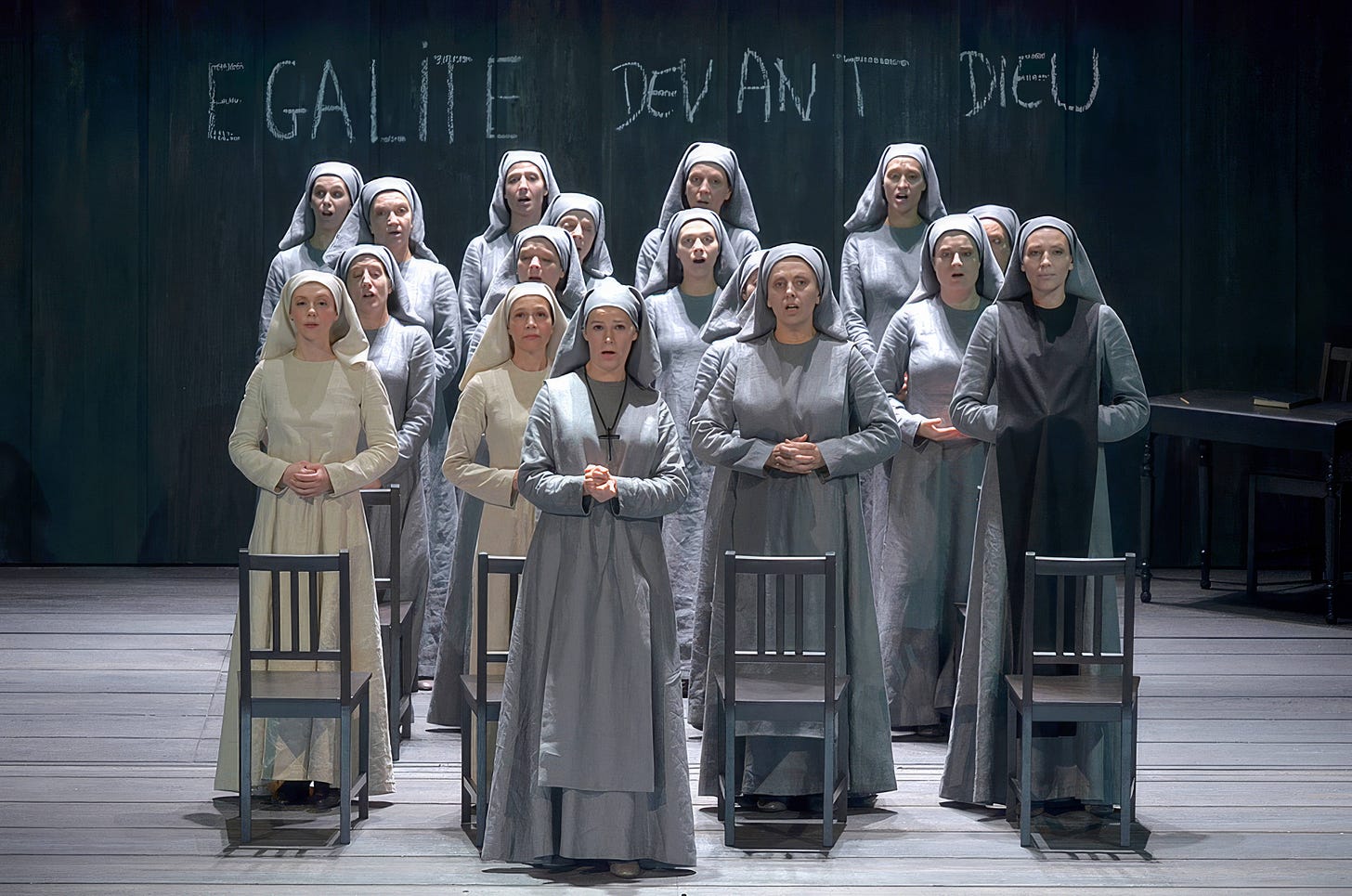
In Paris and all around the world, the spiritual presence of those sacrifices is there below your feet. The view from the Nu‘uanu Pali of Oahu is breathtaking – and something that happened there is under your feet. The city of Lyon, France, is a world heritage site, famous its 2000 years of history, culinary delights, and old-world streets – and something that happened there is under your feet. Barcelona is a stunning city, filled with beautiful examples of Art Nouveau architecture and home to Antoni Gaudí’s amazing Sagrada Família Cathedral – and something that happened there is under your feet.
Paris is a beautiful city. There is every reason to enjoy its beauty and celebrate its centuries of cultural contributions to the world. The Parisians have done an amazing job of preserving its history. The restoration of the Cathedral of Notre Dame is a testament to France’s commitment to its crown jewel of art, architecture, and culture. But while you’re there, give a thought to the spiritual presence infused in the ground below the paving stones.
I do this at every place we visit. Because, for me, enjoying the beauty of what humanity has created comes with remembrance of those who were there before -- how they lived, how they loved, how they endured, and, yes, even how they died. ❖
Author's Notes
This piece is a tribute to my father, who always tried to instill in us that the end never justifies the means. Over the years, I have understood his lesson from studying history and watched it “play out” on the world stage. So, with gratitude, I dedicate this essay to Raymond C Griesemer, my father.
I'm grateful to Pastor Mark Burnham of Grace Presbyterian Church who gave a sermon in 2024 about justice and righteousness existing as two sides of the same coin. His sermon inspired me to research the concept further. There is much biblical scholarship on the topic. I noticed that "justice" is generally presented in the literature without the modifier "social" preceding it. I think this is an important distinction. We live in a society in which justice is enforced through established law. The concept of Social Justice crosses over into morality and, historically speaking, attempts to legislate morality have failed. You can state the morality of your belief, debate with others who don't share your views and try to convince them. But you can never legislate how and what people think to be legal or illegal. As Professor Simon Michael Schama, author of Citizens, stated in a BBC Documentary on the Reign of Terror:
“The schism in the modern world is between those who feel that their version of truth demands that it be enforced and those who feel that the only right you have is to make your case to people who then are left alone to agree or not agree. Our job is to make sure that we can disagree without the obligation to exterminate people who don’t happen to agree with us.” 15
For me, Professor Schama's quote is the prescription for fighting the contagion of Consequentialism.
Regarding Inline Links
As Nicholas Carr writes in The Shallows, What the Internet is Doing to Our Brains:
"Links don't just point us to related or supplemental works; they propel us toward them. They encourage us to dip in and out of a series of texts rather than devote sustained attention to any one of them. Hyperlinks are designed to grab our atte ntion. Their value as navigation tools is inextricable from the distraction they cause." 16
In recognition of this important point, I have decided to provide citations and links to related resources here at the bottom. Even if it's online, let's return reading to being a sustained experience without the constant distractions of links that scream, "go here!"
References
Discalced Carmelite Nuns of Discalced Carmelite Nuns. "Martyrs of Compeigne." Discalced Carmelite Nuns, Monastery of Mary, Mother of Grace,Lafayette, Louisiana. Discalced Carmelite Nuns, Monastery of Mary, Mother of Grace,Lafayette, Louisiana, March 10, 2021. https://doi.org/https://lafayettecarmelites.org/martyrs-of-compeigne/.
Freihalter, G. Paris Saint-Honoré D'Eylau1926.JPG. 2010. Photograph. Wikimedia Commons, September 12, 2010.
Marchant, Katrina. "Dr Kat and the St Bartholomew's Day Massacre." Reading the Past. February 7, 2020. Video, 0:03:35, www.youtube.com/watch?v=ZHnPlrCXK00&ab_channel=ReadingthePast.
Demachy, Pierre-Antoine. a fête de l'Être Suprême, au Champ-de-Mars. 1794. Painting. Wikimedia Commons, circa, 1794.
Foote, Shelby, director. The Civil War. Warner Home Video, 1990. 1 hr., 39 min. https://www.pbs.org/show/civil-war/?source=googlehome&action=play.
Tolkien, J.R.R. 1966. The Fellowship of the Ring. Houghton Mifflin Company. https://doi.org/10.1080/00144940.1996.9934127.
Rowling, J.K. 2000. Harry Potter and the Goblet of Fire. Scholastic Inc. https://doi.org/10.20361/G22C9G.
Wink, Walter. "The Myth OF Redemptive Violence." Goshen College. Goshen College, April 10, 1999. https://doi.org/https://www2.goshen.edu/~joannab/women/wink99.pdf.
Sawan, Amer. What Planets Were Destroyed in Star Wars: The Force Awakens? 2024. CGI Image. Valnet Publishing Group, April 28, 2024.
Wikipedia. 2025. "The Purity Spiral." Wikimedia Foundation. Last modified January 26, 2025. https://en.wikipedia.org/wiki/Purity_spiral.
Acosta, Katherine M. Vancouver Panel on Gender Identity and Media Bias Encapsulates Conflict between Women and Trans Activists. 2019. Photograph. Feminist Current, November 6, 2019.
Rioult , Claire , and Romain Fathi. "The French Revolution Executed Royals and Nobles, Yes – but Most People Killed Were Commoners." The Conversation. July 12, 2023. https://doi.org/https://theconversation.com/the-french-revolution-executed-royals-and-nobles-yes-but-most-people-killed-were-commoners-200455.
Devanzo, Georgio. Google Maps (Search for Proctor's Ledge). 2022. Photograph. Google LLC, October, 2022.
Potent, Vincent. Dialogues Des CarméLites – ThéâTre Des Champs-ElyséEs. 2013. Photograph. WikiSpectacle, August 12, 2013.
Schama, Simon Michael, director. Terror! Robespierre and the French Revolution. Mark Hayhurst, 2019. 1 hr., 30 min. https://www.bbc.co.uk/programmes/b00lrcy4.
Carr, Nicholas. 2011. The Shallows, What the Internet Is Doing to Our Brains. New York, NY: W. W. Norton & Company.
Cover Photo: Nitot, Tristan. Fontaine, Place De La Concorde, Paris. 2005. Photograph. WikiMedia Commons, April 15, 2005.
Further Reading and Resources
The Ballet in An American in Paris
Ballet Philippines 55 presents one the best histories I've read on the 17 minute ballet in An American in Paris: The History of the Greatest Ballet Ever Committed to Film.
The sixteen nuns of the Community of the Carmel of Compiegne
Go directly to the source. This is the story of The Martyrs of Compeigne as told by the Carmelite Order itself.
Documentary on the Reign of Terror
The best documentary I've seen on the Reign of Terror comes from the BBC. It's a captivating mix of historical reenactment by actors and commentary from some of the finest scholars on the French Revolution, the Reign of Terror, and Robespierre, including David Andress, Ruth Scurr, Slavoj Zizek, Marisa Linton, Hilary Mantel, and Simon Michael Schama. It still can be found on YouTube (for now) under the title, Terror! Robespierre and the French Revolution.
The Saint Bartholomew's Day Massacre
Katrina Marchant presents the history of the Saint Bartholomew's Day Massacre and why she believes the event led to the execution of Mary Queen of Scots. An excellent historian, "Dr Kat" presents it all in her video, Dr Kat and the St Bartholomew's Day Massacre.
Who Were the Victims of the Reign of Terror?
Scholars Claire Rioult and Romain Fathi present the truth about who the victims were in the Reign of Terror in this article written for The Conversation, titled, The French Revolution executed royals and nobles, yes – but most people killed were commoners .
Proctor's Ledge
The Smithsonian Institution did a fascinating piece on how the hanging site was found by historians and the help of a 3D virtual camera. After the memorial was completed, it was dedicated on the 325th anniversary of five of the women who were executed, as reported here by CBS Boston.
The House on Un-American Activities Committee
In 1947, this congressional committee began its infamous investigations intended to "root out" and expose Communists in the United States. The cold war had just begun and many Americans were fearful of the Soviet Union. The Committee focused heavily on Hollywood and the film industry, which they believed was enabling subversion of the United States government from within. The studios responded by creating a "blacklist" to demonstrate their patriotism to the Committee. Anyone on the blacklist could have their careers ruined, and some were indeed ruined. Wikipedia presents a descent summery of the HUAC and it's repercussions.
What happened at Nu‘uanu Pali of Oahu
Pacific Worlds presents an excellent history of the price paid by entire families to meet the great king's goal of "unification" of the Hawaiian Islands. To this day, their bones are still being discovered at the base of the cliff they were driven off of by Kamehameha's heavily armed forces.
What happened in Lyon
When Lyon opposed the Jacobin faction of the French Revolution, the city was put under siege. After it fell on October 9, 1793, the Committee of Public Safety exacted retribution by seeking out anyone it suspected of opposing Jacobin rule. The retribution expanded and Lyon is essentially sentenced to death, with much of the city being razed. But, it was not enough for the Jacobins. The Committee sent the fanatical Jean-Marie Collot d'Herbois to finish the job. In the Autumn of that year, Collot grew impatient to move faster. He had the condemned chained together in groups and had his troops fire canister from canon at them. It didn't work well and the soldiers were ordered to finish off the maimed with bayonets. It was so horrendous, the soldiers began refusing to be the instruments of such brutality. In the end, 2,000 people were massacred in Lyon -- people who were Republicans, but of the "wrong type."
What Happened in Barcelona and Other Spanish Cities
On March 31, 1492, King Ferdinand and Queen Isabella signed the Alhambra Decree, giving four months for the Sephardic Jewish people to convert to Catholicism or face the terror of the Spanish Inquisition. Those who chose to stay had to abandon every aspect of their Jewish faith and traditions and become "Conversos," going so far as changing their surnames to purge their lineage of Jewish ancestry. Those who fled scattered around the Mediterranean Sea, creating a far flung diaspora that exists to this day. Pogroms continued in Spanish cites through the following century. Even the Conversos were not safe. Tens of thousands were killed. Hundreds of thousands were forced to flee.
Finally...
Dialogues des Carmelites
Here is a clip from Francis Poulenc’s Dialogues des Carmelites, as performed by the New York Metropolitan Opera in the 2018-2019 season. The guillotine is never seen. It is heard after each sister walks singing into the darkness at the back of the stage, in this, the final scene. It was so powerful, it left me breathless! Don't be surprised if it brings you to tears.
© 2025 Jim Griesemer, all rights reserved

